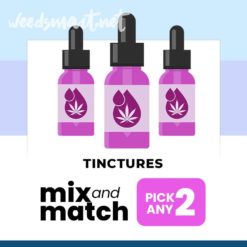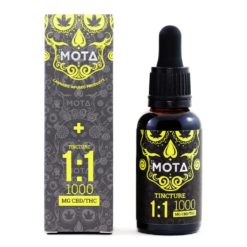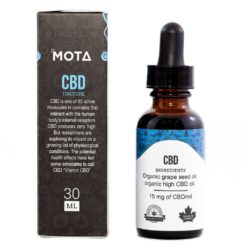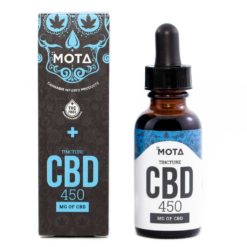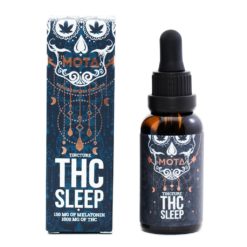Cannabis Oils
What is CBD?
Short for cannabidiol, CBD is one of the multiple chemical compounds you can find in the Cannabis sativa plant. It occurs naturally and is often used in several ways for different reasons. The other compound that is often directly compared to it is THC – tetrahydrocannabinol. However, unlike THC, CBD doesn’t have psychoactive capabilities. That is, after consuming products infused with this compound, you’re not going to get high. Instead, you’re more likely to simply enjoy its benefits as the feeling of calm.
How CBD Works
CBD is a compound that interacts with your body through your cannabinoid receptors. These unique receptors are all part of a larger system known as the endocannabinoid system. To carry out its functions, the human body produces two main cannabinoid receptors: CB1 Receptors and CBD 2 Receptors.
CB1 Receptors: These are all over your body and are particularly common in your brain. These are incredibly important because they help with the coordination of various functions in the human body. These functions include movement, emotion, pain, mood, appetite, thinking, memories, etc.
CB2 Receptors: These aren’t very common across every part of your body. However, they thrive in the immune system. They often affect inflammation and pain.
With THC, the process is a tad straightforward as it merely attaches itself to the CB1 receptors. Only then can its effects be felt. However, things are a tad different with cannabis oils as they stimulate the CB2 receptors instead. Once stimulated, the human body will then create its own cannabinoids. These cannabinoids are known as endocannabinoids.
Buy THC Tinctures and Cannabis Vape Oils
If you want to enjoy the many benefits of marijuana without having to inhale smoke into your lungs, then cannabis oil is what you need. Consuming it requires no accessories or smoking paraphernalia. All you need is a few drops under your tongue and you’re good to go.
The idea is simple; THC is extracted straight from the marijuana plant and mixed with a solution to get a certain concentration. Often found in tinctures, cannabis oils are a staple product of the medical marijuana community because of how easy it is to use them.
They can contain either THC, Cannabidiol or both, depending on what the user prefers. Some are meant to be taken orally while some can be vaporized and inhaled using vape pens.
Effects
The effect of a certain batch of weed oil depends on on what marijuana strains were used, and whether they had indica or sativa properties. Indica dominant strains tend to induce a body high and promote relaxation, euphoria and sedation.
Sativa dominant strains tend to provide a more uplifting and stimulating experience with increased levels of happiness and energy. This cerebral high is what makes sativa weed more preferable for daytime use.
Medical Applications
This form of marijuana consumption has been a cornerstone in the medical marijuana industry for ages, and for good reason. There are many instances where smoking marijuana would not be appropriate. Lucky for users, these can be taken at any time in a timely and discreet manner. Just a few drops under the tongue and away you go!
Some of the most common medical uses include anxiety relief, improved appetite, lowered depression, pain and inflammation relief and insomnia.
Orally active weed is an absolute hit among medical marijuana users for all the right reasons. From a strictly medicinal point of view however, oil that contains Cannabidiol instead of THC seems to have more benefits.
The reason why it works so well is that it impacts the endocannabinoid receptor activity in the body, interacts with various neurotransmitters and significantly reduces inflammation and pain.
Cannabidiol is also known to have properties that inhibit the and growth of cancer cells. That, coupled with the fact that it greatly reduces chemotherapy induced nausea makes it a great alternative medicine for cancer patients. Many doctors actually prescribe it widely.
Because it has such a profound effect on brain signaling systems, cannabidiol has also proven to be neuroprotective in some cases. Other potential benefits include antipsychotic effects, substance abuse treatment, anti-tumor effects and diabetes prevention.
The most significant medical use of cannabidiol oil is that it’s used for the treatment of cancer and childhood epilepsy. Here are some of the most common uses:
- Addiction
- Anxiety
- Arthritis
- Autism
- Depression
- Epilepsy
- High Blood Pressure
- Inflammation
- Insomnia and Sleep Disorders
- Multiple Sclerosis
- Nausea and Vomiting
- Pain Relief
- Skin Conditions
- Cancer
- Stress
Negative Effects
As usual, cottonmouth and red/dry eyes are common side effects of cannabis products. However, these effects are not too serious and aren’t really physically or mentally harmful at all.
Just like any other substance, taking too much of it isn’t a great idea. If taken in excess, it can cause dizziness, nausea, paranoia, and high blood pressure. The best thing to do is take very little to begin with, stay within reasonable limits and you will be just fine.
Types of Cannabis Oils
Oils have been around for such a long time that one could assume there are many different variations, and one would be correct. Here are some of the most popular varieties:
THC:
Tetrahydrocannabinol or THC is a psychoactive compound found in cannabis. The oil is made from THC-rich flowers and has a number of benefits.
It relieves symptoms of pain, nausea, and vomiting in cancer patients. Those suffering from eating disorders seem to regain their lost appetite after consumption.
Honey:
Because of its golden color and gooey texture, honey oil is the common way of referring to hash oil. Call it whatever you like, this substance is known for its high levels of THC which makes it potent.
It can be smoked, dabbed, vaped, eaten, and even applied topically. It is commonly used to make cannabis shatter and wax.
Just like other cannabis derivatives, it offers relief from pain, inflammation, and is a popular choice for treating cancer patients
Rick Simpson Oil (RSO):
Rick Simpson Oil or RSO is a highly concentrated form of cannabis oil. It is named after Rick Simpson, who created the oil to treat his skin cancer and successfully recovered after using it.
RSO can be consumed both sublingually, orally, or used topically for skin ailments. It has a high THC concentration and is used to treat depression, insomnia, arthritis, asthma, and other illnesses.
Because of its bitter taste, many prefer to consume it orally instead of keeping it under the tongue.
Hemp:
Hemp oil is often confused with cannabidiol oil. Both these come from different parts of the cannabis plant.
While hemp oil does contain some cannabidiol, it has a lot more in there like phytocannabinoids, terpenes, and flavonoids.
Hemp oil can either be full or broad spectrum. Medical marijuana patients will get more out of the full spectrum variant thanks to the potency.
Hemp Seed Oil:
Unlike hemp oil, hemp seed oil does not contain active cannabidiol. It is extracted by cold-pressing the seeds of Cannabis sativa plants.
It is rich in protein, minerals, vitamins, omega-3, and omega-6 fatty acids. It is used for its nutritional properties and ingesting it will not get you high. It does, however, help improve immunity and cardiovascular health along with relieving constipation.
Cannabidiol Oil:
Cannabidiol oil is easily one of the most popular cannabis extracts because of its many benefits. It is used to calm anxiety, stress, reduce insomnia, and help with chronic pain relief.
Because of its low THC levels, you won’t experience the same type of “high” but you will end up feeling more relaxed.
Best Consumption Methods
Just a few drops under your tongue is all that is needed for the wonderful effects to kick in. The reason for this is that when you place the medicine under your tongue instead of simply swallowing it like a pill, it actually enters your bloodstream directly.
If you swallow it like a pill, it’s going to have to go through your digestive system and get metabolized by the liver before you can feel the effects.
It is recommended to hold the weed oil under your tongue for 30 seconds to a minute so that it can be more bioavailable and induce the desired effects as quickly as possible. It is also possible to add this to beverages or to infuse it with edibles.
Questions to Ask While Shopping for CBD Products
At this point, there are hundreds of places you can get THC oil or CBD oil in Canada. This is partly due to the legalization of the plant in Canada. Generally, this could be a good thing. The availability of numerous CBD brands means you’ll have more options. However, it could also mean that there will be different brands that don’t exactly concern themselves with quality. These are the ones you should watch out for. So, if you’re going to purchase any CBD product, you should ask yourself the following questions:
- Are there any labels?
Generally, most products come with a label of some sort. Even if it’s the brand’s logo, you’ll still find something there. But, that’s not what we’re talking about. A proper CBD product should have a label certifying its authenticity and giving warnings about its use. It would also be very helpful if you could get access to the third-party lab-testing results of the product itself. But, in absence of that, carefully look for a certifying label from the national drug regulating agency.
- Does it even have any third-party testing?
Indeed, cannabis is legal in Canada. However, it is still properly regulated because it is a consumable product. And, like every other of its kind, it could potentially cause a lot of damage if not carefully monitored. For this reason, CBD brands are required to conduct a lab test of their products. The purpose of this test is to ensure that it is safe for consumption. Alongside that, the test shows that the product has the right amount of CBD in comparison to the other chemicals in a cannabis plant.
So, before purchasing, try to figure out if the product has a test that proves its excellence and safety. To do this, you can simply look at the product’s label. There should be a sort of certificate of analysis or quality assurance stamp attached. If it isn’t on the product, you can do a quick sweep of the company’s website to find out.
- What is the proper dosage?
This part can be a bit of a challenge to many customers. The reason is that many brands do not often include their dosing on the bottles. But, before you even purchase the product, you should carefully check to see what the dosage is like. To do this, you need to consider whether your CBD product is full-spectrum or isolate.
Full-spectrum CBD products can include other forms of CBD like cannabigerol or cannabidivarin. Taking all these together could lead to something known as the entourage effect. Isolate products, on the other hand, only include CBD. The difference between the two is that some people only require about 10mg of the former given its increased potency. However, with the latter, users can take up to 80mg to feel the same effect.
If the company doesn’t clearly state their dosage on the bottle, you can simply talk to your doctor. They’ll be in the best position to advise you on how much CBD to consume.
- Does it cure any diseases?
CBD is a wonderful drug with many positive health effects. However, only Epidolex is approved for treating a disease – epilepsy. So, if any CBD product besides Epidolex claims to cure any diseases besides epilepsy, you should definitely avoid it. It isn’t approved and they’re merely trying to get more customers by making unfounded promises.
- Any additional ingredients?
Before buying your cannabis oils, or even THC vape oil, make sure to check for additional ingredients. Some manufacturers often include other additives in their products to boost the product’s marketability. While this might be good, it could also be dangerous. The reason is that you might react wrongly to one of the ingredients. Generally, CBD is very safe. But, if there’s an ingredient there that could harm you, knowing beforehand could save you a lot of trouble.
- Does it have a batch number?
Occasionally, manufacturers recall products. This is often done when they notice that something is wrong with the product and the general public shouldn’t be consuming it. If this has ever happened to you, we can guess that you had to check the batch number to make sure you didn’t buy the one getting recalled. Doing this would save you the trouble of tossing out your product out of fear or keeping it and getting sick from its use.
Well, you should be able to do the same thing with your CBD product. A proper brand should allow its customers to easily identify products with the batch number. This doesn’t exactly increase the safety of the product. But, it does increase the legitimacy of the company producing it.
Alternatives
Other ways to eat THC products is buy using weed edibles. The great thing about edibles is that THC can pretty much be added to just about anything.
For smoking alternatives, flowers are the way to go. This is by far the most common method of marijuana consumption and is normally a large part of cannabis users lives. If something stronger is the goal, then concentrates such as budder, shatter, live resin, hash and distillates could fit the bill.
Best Place to Buy THC Vape Oil and Other Cannabis Oils
Our top priority is to ensure that you receive the highest quality products your money can buy. We offer a massive variety of top shelf marijuana products by authority brands such as MOTA, Faded, and many more!
Fill up your cart today and take full advantage of our special promotions, deals and offers! Save big and shop smart with Weed Smart.
References:
- US National Library of Medicine. Cannabidiol (CBD). Accessed January 21, 2021 at https://medlineplus.gov/druginfo/natural/1439.html.
- Hui-Chen Lu and Ken Mackie. An introduction to the endogenous cannabinoid system. Accessed January 21, 2021 at https://www.ncbi.nlm.nih.gov/pmc/articles/PMC4789136/.
- Shenglong Zou and Ujendra Kumar. Cannabinoid Receptors and the Endocannabinoid System: Signaling and Function in the Central Nervous System. Accessed January 21, 2021 at https://www.ncbi.nlm.nih.gov/pmc/articles/PMC5877694/.
- Cannabis Act (S.C. 2018, c. 16). Justice Laws Website. Accessed January 21, 2021 at https://laws-lois.justice.gc.ca/eng/acts/c-24.5/.
- Ferber, Sari G.; Namdar, Dvora; Hen-Shoval, Danielle; Eger, Gilad; Koltai, Hinanit; Shoval, Gal; Shbiro, Liat; Weller, Aron. The “Entourage Effect”: Terpenes Coupled with Cannabinoids for the Treatment of Mood Disorders and Anxiety Disorders. Accessed January 21, 2021 at https://www.ingentaconnect.com/contentone/ben/cn/2020/00000018/00000002/art00004.
- Statement by FDA Commissioner Scott Gottlieb, M.D., on the importance of conducting proper research to prove safe and effective medical uses for the active chemicals in marijuana and its components. Accessed January 21, 2021 at https://www.fda.gov/news-events/press-announcements/statement-fda-commissioner-scott-gottlieb-md-importance-conducting-proper-research-prove-safe-and.
- G. Fournier, C. Richez-Dumanois, J. Duvezin, J.-P. Mathieu, M. Paris, Identification of a New Chemotype in Cannabis sativa: Cannabigerol – Dominant Plants, Biogenetic and Agronomic Prospects. Accessed January 21, 2021 at https://www.thieme-connect.com/products/ejournals/abstract/10.1055/s-2006-962705.



